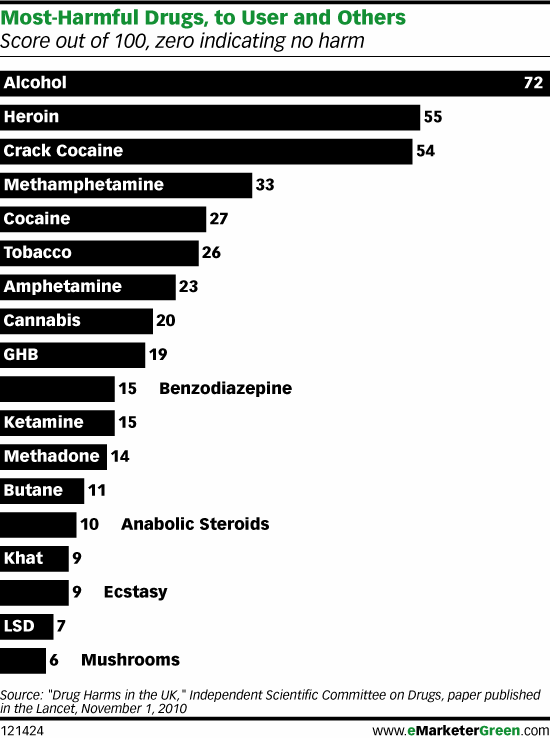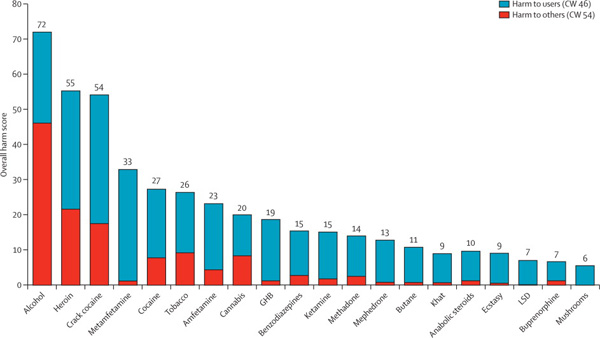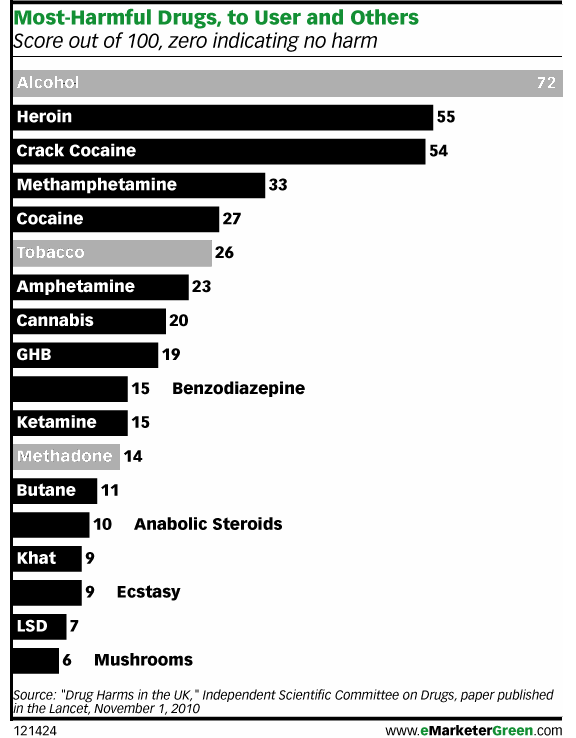
How is the scoring system determined?
British researchers affiliated with the Independent Scientific Committee on Drugs met for a one day workshop and constructed a composite scoring system to determine which drugs are most harmful both to individuals and to society collectively. Scores can range from 0 – 100. Authors David Nutt, Leslie King and Lawrence Phillips found that,
heroin, crack cocaine, and metamfetamine were the most harmful drugs to individuals (part scores 34, 37, and 32, respectively), whereas alcohol, heroin, and crack cocaine were the most harmful to others (46, 21, and 17, respectively). Overall, alcohol was the most harmful drug (overall harm score 72), with heroin (55) and crack cocaine (54) in second and third places.
The full list of factors that were included in the composite score are here:
- Mortality
- Damage
- Dependence
- Impairment of mental functioning
- Loss of tangibles
- Loss of relationships
- Injuries to others
- Crime increase
- Environmental degradation
- Family breakdowns
- International turmoil
- Economic cost
- Loss of community cohesion and reputation
Though it is possible to go into an explanation of how each of these was measured and subsequently combined to produce the composite scores, I am going to leave that discussion to the authors of the original study. There’s an overview graph below and the full article Drug Harms in the UK: A multi-criteria decision analysis is at the Lancet.

What can be done?
I found it interesting that there was no attempt made to distinguish between legal and illegal drugs. Yes, of course, some drugs are not clearly legal or illegal. They are legal when prescribed and supervised by a doctor but illegal when used off-label or outside the medical authority system (like anabolic steroids, methadone, and marijuana in California). I assumed that most methadone users are under some kind of supervision but that most anabolic steroid users are using the steroids off-label (ie illegally). You can quibble with my choices below. The point here is that I found the graph to have more context if the legality issue was visually inscribed into it.

There are age limits and places where it’s illegal to smoke or drink, but for the most part everyone will be able to use alcohol and tobacco legally for most of their lives. Methadone is probably being used legally in most cases. That’s why I shaded those bars grey. I am not expert on methadone, but I see that it is much less harmful to users and to society than heroin, the drug it stands in for, so I guess if this were the only data I had to make a decision about continuing methadone treatment programs, I would keep them going. I would also call for close scrutiny of methadone programs. Something is clearly not working as well as it could be.
As for alcohol and tobacco…well…it’s hard to argue *for* the continuing legality of alcohol. How large do detriments to society have to be to trigger additional control mechanisms? The authors of the study noted that alcohol is part of society and it isn’t going anywhere. I agree. Prohibition was a failed experiment in this country and I’m not suggested we try it again. However, I would like to reopen the debate about how the negative impacts of alcohol can be alleviated. I recommend that all new cars must have breathalyzers in them. If the driver cannot blow a legal sample, the car won’t start. Yes, people could game that system by having their friends blow for them, but often one’s friends are also drunk. And hopefully, friends really wouldn’t let their friends drive drunk. Once upon a time, seatbelts were considered extraneous and seatbelt laws were considered constraints upon American’s rights to freedom and the pursuit of happiness. Well, when a drunk driver kills one of your family members, you might decide that the sudden loss of your mother or son or niece puts a much bigger crimp in your pursuit of happiness than a breathalyzer in your car ever would have. Will breathalyzers make cars cost more? Probably. But the cost of dealing with car accidents caused by drunken driving, even when they aren’t fatal, is absorbed by random individuals who happened to be in the wrong place/time as well as tax payers who pay to repair guard rails, subsidize public hospitals and EMTs, pay cops’ salaries, and so on.
References
Nutt, David J, Leslie A King, and Lawrence D Phillips. (6 November 2010) “Drug harms in the UK: a multicriteria decision analysis” The Lancet, Vol 376(9752): 1558 – 1565.

Comments 21
3countylaugh — May 10, 2011
I'd love to see this contrasted to Netherland's drugs statistics for the same reasons you state above, how does legality impact these numbers? If you knew, could you control for that in the UK numbers? so hard to tell.
Misty — May 10, 2011
THANK YOU~~all good points thanks for the information I have had to express to people how much more dangerous alcohol is yet since its not illegal makes for a frustrating argument
Bob — May 11, 2011
I'll drink a pint of beer and you drink a pint of LSD and we'll see which of us dies first.
Wade Coye — May 11, 2011
The tragedies that can result from someone driving under the influence of drugs or alcohol is unfortunately something I see in my practice frequently. While I agree that the impact alcohol has on both an individual and societal level is by far the most recognizable, I'm not convinced that a breathalizer as standard vehicle equipment would work in practicum. It is a difficult balance between maintaining individual rights and social safety, and in that instance it seems that drivers without any history of driving under the influence may have a reasonable complaint. Thanks for sharing this study and your thoughts and ideas on ways to help decrease the emotional, physical, financial, and total social impact that irresponsible drivers have on "random individuals" and taxpayers.
Befuzzled — May 11, 2011
@Bob yes, because obviously the standard dose of LSD is a pint, just as the standard dose of whiskey is a pint. Duh?
g99 — May 11, 2011
You easily can buy a lethal dose of alcohol but a lethal dose of LSD costs a lot...
“¿Te molestan las drogas que uso?” | Pijamasurf — May 11, 2011
[...] [The Society Pages] ENVIAR POR MAIL IMPRIMIR TAMAÑO DE TEXTO [...]
Frankie Hill — May 13, 2011
I'd be interested to know how Methadone and Heroin would stack up against each other if the using circumstances were identical. If Heroin was prescribed and the purity of it was consistent and users did not have to associate with criminals to access it, I have a strong suspicion that the harm equation may change....my understanding is that clean Heroin i.e. uncut with other substances to make it go further, is far less toxic than Methadone, a synthetic drug developed by Nazi scientists.
"Side" effects of Methadone include:
Constipation; dizziness; drowsiness; dry mouth; headache; increased sweating; itching; lightheadedness; nausea; vomiting; weakness.Body as a Whole – asthenia (weakness), edema, headache
Cardiovascular – arrhythmias, bigeminal rhythms, bradycardia, cardiomyopathy, ECG abnormalities, extrasystoles, flushing, heart failure, hypotension, palpitations, phlebitis, QT interval prolongation, syncope, T-wave inversion, tachycardia, torsade de pointes, ventricular fibrillation, ventricular tachycardia
Digestive – abdominal pain, anorexia, biliary tract spasm, constipation, dry mouth, glossitis
Hematologic and Lymphatic – reversible thrombocytopenia has been described in opioid addicts with chronic hepatitis
Metabolic and Nutritional – hypokalemia, hypomagnesemia, weight gain
Nervous – agitation, confusion, disorientation, dysphoria, euphoria, insomnia, seizures
Respiratory – pulmonary edema, respiratory depression
Skin and Appendages – pruritis, urticaria, other skin rashes, and rarely, hemorrhagic urticaria
Special Senses – hallucinations, visual disturbances
Urogenital – amenorrhea, antidiuretic effect, reduced libido and/or potency, urinary retention or hesitancy
I'm not suggesting that Heroin has no nasty side effects but I think the Methadone program is one of the biggest pharmaceutical cons of the western world....why not just give out clean Heroin? Why the need to create a second addiction to a very nasty drug? The only thing that makes sense to me is....MONEY and lots of it.
Jay — May 15, 2011
"I recommend that all new cars must have breathalyzers in them. If the driver cannot blow a legal sample, the car won’t start. Yes, people could game that system by having their friends blow for them, but often one’s friends are also drunk."
Sorry, but I'm the child of an alcoholic, and if you think for one minute that this is going to work, then you're mistaking.
An alcoholic will make their partner/children blow to start the car, simple as that. And if they refuse ? well, they'll just be beaten up twice as much as they usually are.
Alcoholic or not, people who are drunk will almost always find a way to make someone else start the car.
On top of that, after the drunk person goes and kill someone with the car that *someone else* started for them, then who will get the responsibility ? The 12 years old that is beaten up daily ? The distraught partner ? The friend who didn't think before helping another friend ? Seriously, what do you think defense attorneys are going to do when these questions come up ?
The idea is all well and nice, but the one thing it will not do is help the daily torture that the families live already, and thus, alcohol will go even higher on your graph than it already is.
God — May 17, 2011
I have NEVER seem anything good come from any of the above listed drugs
Does my drug use bug you? « beatsnpeace — May 23, 2011
[...] Link: Does my drug use bug you? [...]
“¿Te molestan las drogas que uso?” | Diario de un Marihuanero — June 5, 2011
[...] [The Society Pages] [...]